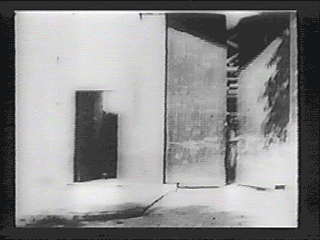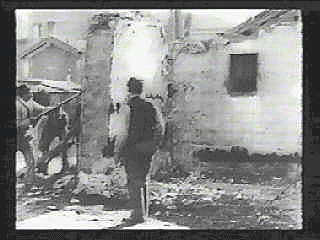
The Event of the Cinema
One sort of history is a memory of
those events which have happened forever. In such an account the physical
invention of the cinema matters less, it seems to me, than the occasion
of its first manifestation. The invention-- assembling wheels and springs,
forming loops of flexible perforated film, setting intermittent shutters,
positioning Maltese crosses--all this has no significance as event, as
action; whereas the complex of people and machinery, looking and projecting,
sitting still and moving which occurred once and forever several times
in the late nineteenth and early twentieth century--that bears a remarkable
significance insofar as it is an event. It is like setting up the first
pillar in the first settlement, or seeing white people coming from the
reflecting sea: something worth remembering and repeating a thousand different
ways, something made for us to understand.
Of course, the invention of a machine is very specific and in that way looks much more like an event than the vague experience which I am addressing here. Whirr, click . . . it works! Nothing will ever be the same again. Yet invention, the eventfulness of fabrication, is fundamentally an illusion--its singularity, even its power to shape the future, a sham. For the invention, as an invention, is only one crest of the endless ripples of causation, an inevitable, foreordained conclusion of a logical sequence. Its world-altering determinism, likewise, is prefigured in its past, merely the articulation of rules, an instance of a generality. The first showing, the presentation, on the other hand, possesses a phenomenological claim to our attention which derives precisely from its renewable originality. Presentation is of no particular interest so long as it is approached in the manner of science, that is, as evidence for the operation of law. But it compels investigation when we ask about our particular experiences of the screen, that is, when it is approached analogically or metaphorically--for its truth, if you will.
All of which may serve to explain why I choose to begin this account with an event of dubious empirical value: the screenings on the Boulevard des Capucines organized by the Lumière brothers and commencing on December 28th, 1895. What happened there and then had happened before and elsewhere and was to happen again, interminably everywhere; but the repetition does not matter, for it is a repetition of singularity, presentation each time, a renewal, each instance exemplary and emblematic. Always and forever we, the well-fed and curious bourgeoisie of the fin de siècle, stroll into the Grand Café, dig into our pockets and purses for a franc and settle down together in the dark, staring at a wall of white.
And the show begins.

But in that short time we have known ourselves displaced. The place where we began was altered, in some sense overcome. We were not there, at the same time that we were not elsewhere. We were simultaneously outside and inside ourselves, up on the screen and someplace deep within. The movement which takes place "apparently" "on the screen" and "actually" "inside our heads" drastically changes our experience of space by projecting attention onto a two-dimensional surface in front while at the same time demanding interior identification with the traces of action which, more often than not, evoke three dimensions. The result is a dialectic of artifice and reality pertinently characterized by Christian Metz, as "a place consisting of actions, objects, persons, a time and a space (a place similar in this respect to the real), but which presents itself of its own accord as a vast simulation, a non-real real".
In the wake of the Lacanian-inspired theories of Metz and Jean Baudry, film writing tended to stress the identification or interiorization side of this dialectic, locating the experience within the confines of Lacan's imaginary, which was treated, tacitly following Louis Althusser's ideological appropriation of it, as always-already-there. Whatever its merits as a psycho-social account of enculturation via the cinema, this notion of spectatorship, by failing to give due weight to what falls outside myself in my experience of a film, can render only an attenuated and banal analysis of cinematic experience: a static description of place as it is represented, as though the film and I are one. Edgar Morin's earlier description of the spectator's situation as one of "projection/identification", not to mention Jean Mitry's understanding that "in the cinema I am at the same time in this action and outside it, in this space and outside this space", are formulations which, because of their insistence on the dialectical nature of the relation between spectator and film, seem eminently more productive.
For interior space is complete, finished (and this even includes the space that narrative theory calls the "diegesis", the fictional universe). Movement in this space is always held within bounds, retracing known paths. Indeed, in this space motion is finally of no real significance, for it can take one nowhere. But if we are projected to a space outside ourselves, then movement is supremely important, for movement reveals that space which was not known before and by so doing suggests sense, becomes action.
In the first film showing we find ourselves flying into the screen, pulled by the movement of the doors of the Lumière factory. At each moment we cannot be certain what will happen next. We know that we are on some kind of trajectory, but what that path is will not be clear until the end. We become involved in a process of a spatial change, the opening of the doors, and the concurrent creation and destruction of a space-time, the fundamental characteristic of which is precisely that we are "always-not-there".
There can be no doubt that time, as it is articulated in movement, is an essential factor in this experience. But it is not the only essential factor. Another is what might be called the bounded quality of the screen. Normally, movement through space allows for a turning back, looking around and over one's shoulder. The cinema, as anyone who loves to be frightened must be aware, does not permit that. The physical limits of the screen--its edges, its place before me, its actual flatness-- limit also the field of repetition to re-runs, instant replay. I cannot see where I have been before and I cannot be sure where I am headed.
At the same time, it does not seem accurate to characterize this state, as some have done, as some kind of super-present. In the present surely past and future would have no effect, no significance. Time would stop in that sense. Yet cinematic space-time, what I have confusingly called "presentation", is where past and future are constantly meeting, disputing the territory as they do in one of Kafka's parables, called "HE".
He has two antagonists: the first presses him from behind, from the origin. The second blocks the road ahead. He gives battle to both. To be sure, the first supports him in his fight with the second, for he wants to push him forward, and in the same way the second supports him in his fight with the first, since he drives him back. But it is only theoretically so. For it is not only the two antagonists who are there, but he himself as well, and who really knows his intentions? His dream, though, is that some time in an unguarded moment--and this would require a night darker than any night has ever been yet--he will jump out of the fighting line and be promoted, on account of his experience in fighting, to the position of umpire over his antagonists in their fight with each other. (Qtd. in Arendt)Another film demands our attention.
Angled from the left to the center of the screen a stone wall, and to the right of that a worker with a pick, directed to pound at it by a man wearing a vest. At a signal the worker moves to the far left and, joined by another, shoves at the wall with his pick. The wall topples, dissolving in dust and smoke which billow over the screen and gradually clear away, as the workers leap upon the rubble and begin to break it up in earnest.
But it is not over yet.
The sound of the machine behind us changes. From the fragments and the frantic hacking of the workers, clouds of dust arise again, swirling across the screen, veiling it all in transparent white, only to be sucked back into the stones which spring from the ground, leaping to their positions in the wall as it rebuilds itself despite, or because of, the workers' picks, now seeming to act as magnets, pulling the wall back into existence.
This is the film called Démolition
d'un mur (Demolishing a Wall) and I have described it as it
was shown - both forward and backward - in the Grand Café.

But what is unstable appears also, by that token, incoherent, entropic. Démolition d'un mur hovers always between unmaking and making, between white clouds and grey shapes, past and future. Only, perhaps, in a final forward projection does it attain the fixity of what its title has promised (and even then, who knows?, it might all run back again). If this is so, then writing the cinema might also appear incoherent, pointless and looped. That is not the way writing should be, or at least that is not the way many who have written about the cinema have believed that writing should be. They have proceeded according to the more or less scientific hypothesis that if understanding is to be achieved, it must come from larger units, from the direction of transformation, from the pattern or vector of change.
2. This animated gif intends to preserve the chronology and some of the sense of Sortie d'Usine using only a few images from the film. The version from which the images were abducted is apparently neither the first nor the second one shot, both of which include larger vehicles and horses. It may be the third, dated 15 August 1896, to which Aubert and Seguin assign the number 687 (215). Back to main text.
3. This animated gif concentrates on the "magical" effect of the wall reassembling itself. It has been constructed from images from the second--and best-known--version of the film, featuring Auguste Lumière (number 691 in Aubert and Seguin, 216). Back to main text.